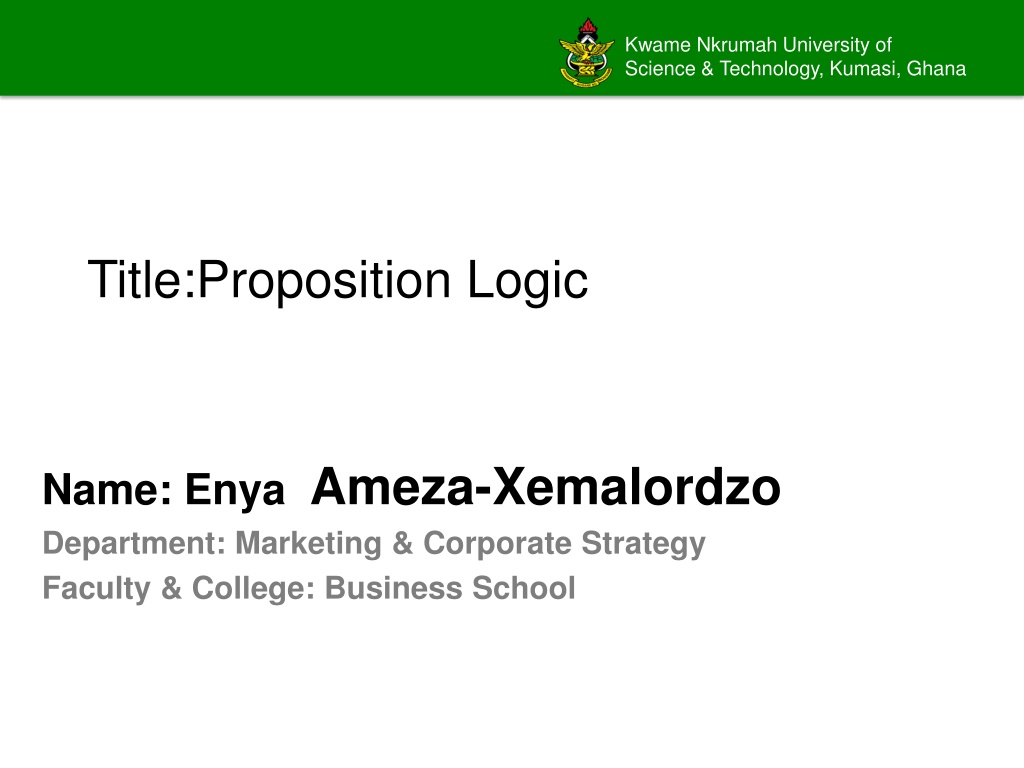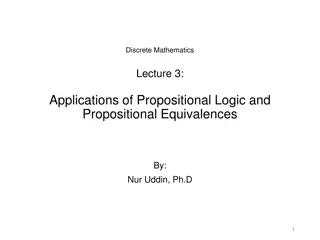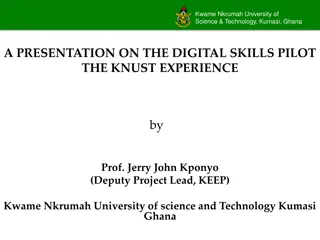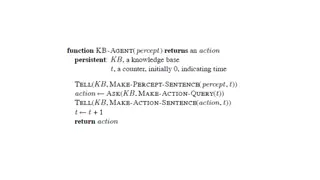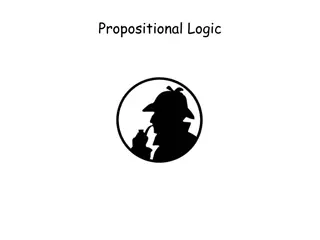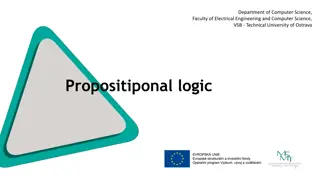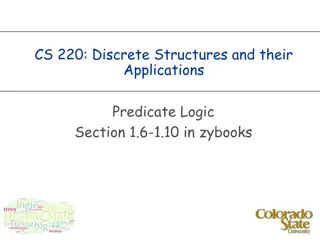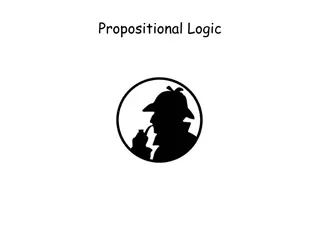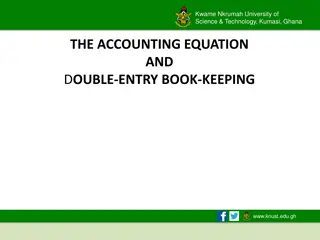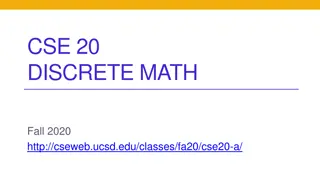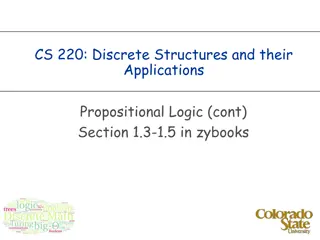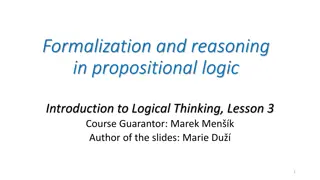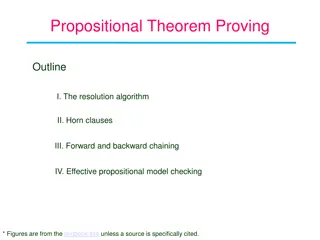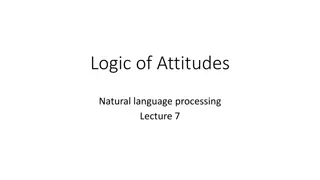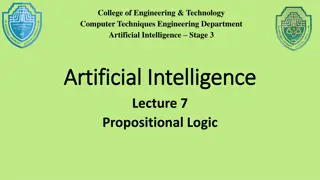Understanding Propositional Logic at Kwame Nkrumah University
Dive into the world of symbolic logic and compound statements with a focus on Propositional Logic at Kwame Nkrumah University in Ghana. Explore the concepts of connectives, simple and compound statements, truth values, and more. Enhance your logical reasoning skills through a tutorial on symbolic logic development.
Download Presentation

Please find below an Image/Link to download the presentation.
The content on the website is provided AS IS for your information and personal use only. It may not be sold, licensed, or shared on other websites without obtaining consent from the author. Download presentation by click this link. If you encounter any issues during the download, it is possible that the publisher has removed the file from their server.
E N D
Presentation Transcript
Kwame Nkrumah University of Science & Technology, Kumasi, Ghana Title:Proposition Logic Name: Enya Ameza-Xemalordzo Department: Marketing & Corporate Strategy Faculty & College: Business School
SYMBOLIC LOGIC TUTORIAL
Connectives - words such as and, or, if, then Exclusive or - one or the other of the given events can happen, but not both. Inclusive or - one or the other or both of the given events can happen.
Statement - A sentence that can be judged either true or false. Labeling a statement true or false is called assigning a truth value. Simple Statements - A sentence that conveys only one idea. Compound Statements - Sentences that combine two or more ideas and can be assigned a truth value.
Statements In this section we will study symbolic logic which was developed in the late 17th century. All logical reasoning is based on statements. A statement is a sentence that is either true or false.
Which of the following are statements? The 2004 Summer Olympic Games were in Athens, Greece.(Statement - true) Seinfeld was the best TV comedy of all time. (Not a Statement opinion) Did you watch The Godfather? (Not a statement a question) The Philadelphia Eagles won Super XV. (statement false) I am telling a lie. (not a statement paradox)
Statements Traditionally, symbolic logic uses lower case letters to denote statements. Usually the letters p, q, r, s, t. Statements get labels. p: It is raining.
Compound Statements A compound statement is a statement that contains one or more simpler statements. Compound statements can be formed by inserting the word NOT, joining two or more statements with connective words such as AND, OR, IF THEN, ONLY IF, IF AND ONLY IF.
The relations between elements that every deductive argument must employ Helps us focus on internal structure of propositions and arguments We can translate arguments from sentences and propositions into symbolic logic form Simple statement : does not contain any other statement as a component Charlie is neat Compound statement : does contain another statement as a component Charlie is neat and Charlie is sweet
Examples Steve did not do his homework. This is formed from the simpler statement, Steve did his homework. Mr. D wrote the MAT114 notes and listened to a Pink Floyd CD. This statement is formed from the simper statements: Mr. D wrote the MAT114 notes. Mr. D listened to a Pink Floyd CD. Compound statements are known as negations, conjunctions, disjunctions, conditionals or combinations of each.
Negation: -, Conjunction: ,& Disjunction: (almost always used as in this text) Conditional: Biconditional:
Statements consisting of two or more simple statements are called compound statements. The connectives often used to join two simple statements are and, or, if then , and if and only if.
The symbol used in logic to show the negation of a statement is ~. It is read not .
NEGATION ~p The negation of a statement is the denial of that statement. The symbolic representation is a tilde ~. Negation of a simple statement is formed by inserting not. Example: The senator is a Republican. The negation is: The senator is not a Republican.
Negation of a statement - the opposite meaning of a statement. The negation of a false statement is always a true statement. The negation of a true statement is always false. Quantifiers - words such as all, none, no, some, etc
Write the negation of the statement. Some candy bars contain nuts. Since some means at least one this statement is true. The negation is No candy bars contain nuts, which is a false statement.
Write the negation of the statement. All tables are oval. This is a false statement since some tables are round, rectangular, or other shapes. The negation could be Some tables are not oval.
Negation All of Mr. D s students are Philadelphia Eagles fans. The negation is: Some of Mr. D s students are not Philadelphia Eagles fans. To negate the first statement, we don t need to have all the students to be not Eagles fans, we just need only one student not to be an Eagles fan. Hence the usage of some.
Negation No students are math majors. To deny this statement, we need at least one instance in which a student does major in math. Some students are math majors.
Negation To summarize negation: All p are q is negated by Some p are not q No p are q is negated by Some p are q
is the symbol for a conjunction and is read and. The other words that may be used to express a conjunction are: but, however, and nevertheless.
Write the conjunction in symbolic form. The dog is gray, but the dog is not old. Solution: Let p and q represent the simple statements. p: The dog is gray. q: The dog is old. In symbol form, the compound statement is p q .
CONJUNCTION p ^ q A conjunction is a compound statement that consists of 2 or more statements connected by the word and. And is represented by the symbol ^. p ^ qrepresents p and q . Example: p: Jerry Seinfeld is a comedian. q: Jerry Seinfeld is a millionaire. Express the following in symbolic form: i. Jerry Seinfeld is a comedian and he is a millionaire. ii. Jerry Seinfeld is a comedian and he is not a millionaire.
Conjunction Express the following in symbolic form: a. The lyrics are controversial and the performance is banned. b. The lyrics are not controversial and the performance is not banned. Answers: a. p ^ q b. ~p ^ ~q Using the symbolic representations p: The lyrics are controversial. q: The performance is banned.
Conjunction of two statements: and Each statement is called a conjunct Charlie is neat (conjunct 1) Charlie is sweet (conjunct 2) The symbol for conjunction is a dot (Can also be & ) p q P and q (2 conjuncts)
Truth value: every statement is either T or F; the truth value of a true statement is true; the truth value of a false statement is false
Truth value of conjunction of 2 statements is determined entirely by the truth values of its two conjuncts A conjunction statement is truth-functional compound statement Therefore our symbol (or & ) is a truth- functional connective
Truth Table of Conjunction Given any two statements, p and q p T q T p q T T F F F T F F F F A conjunction is true if and only if both conjuncts are true
Charlies neat and Charlies sweet. N S Dictionary: N= Charlie s neat S= Charlie s sweet Can choose any letter to symbolize each conjunct, but it is best to choose one relating to the content of that conjunct to make your job easier Byron was a great poet and a great adventurer. P A Lewis was a famous explorer and Clark was a famous explorer. L C
Jones entered the country at New York and went straight to Chicago. and here does not signify a conjunction Can t say Jones went straight to Chicago and entered the country at New York. Therefore cannot use the here Some other words that can signify conjunction: But Yet Also Still However Moreover Nevertheless (comma) (semicolon)
The disjunction is symbolized by and read or. Example: Write the statement in symbolic form. Carl will not go to the movies or Carl with not go to the baseball game. Solution: p q
The conditional is symbolized by and is read if-then. The antecedent is the part of the statement that comes before the arrow. The consequent is the part that follows the arrow.
Example: Write a Conditional Statement Let p: Nathan goes to the park. q: Nathan will swing. Write the following statements symbolically. If Nathan goes to the park, then he will swing. If Nathan does not go to the park, then he will not swing. Solutions: a)b) p q p q
DISJUNCTION p v q When you connect statements with the word or you form a disjunction. Or is represented by the symbol v. p v q is read as p or q . Using the p and q from the last slide, write out in words p v q, and p v ~q. p v q is the lyrics are controversial or the performance is banned. p v ~q is the lyrics are controversial or the performance is not banned.
Disjunction of two statements: or Symbol is v (wedge) (i.e. A v B = A or B) Weak (inclusive) sense: can be either case, and possibly both Ex. Salad or dessert (well, you can have both) We will treat all disjunctions in this sense (unless a problem explicitly says otherwise) Strong (exclusive) sense: one and only one Ex. A or B (you can have A or B, at least onebut not both) The two component statements so combined are called disjuncts
Disjunction Truth Table p T q T p v q T T F T F T T F F F A (weak) disjunction is false only in the case that both its disjuncts are false
Translate: You will do poorly on the exam unless you study. P= You will do poorly on the exam. S= You study. P v S Unless = v
The conditional is symbolized by and is read if-then. The antecedent is the part of the statement that comes before the arrow. The consequent is the part that follows the arrow.
Example: Write a Conditional Statement Let p: Nathan goes to the park. q: Nathan will swing. Write the following statements symbolically. If Nathan goes to the park, then he will swing. If Nathan does not go to the park, then he will not swing. Solutions: a)b) p q p q
CONDITIONAL p q A conditionalis of the form if p then q . This is also known as an implication. p is the hypothesis (or premise), and q is the. conclusion. The representation of if p then q is p q. Again use the p and q from the previous 2 slides. If the lyrics are not controversial, the performance is not banned. ~p ~q
Sec. 1.2 #28 Using the following symbolic representations p: I am innocent. q: I have an alibi. express the following in words. A. p ^ q Answer: I am innocent and I have an alibi. B. p q Answer: If I am innocent, then I have an alibi. C. ~q ~p Answer: If I do not have an alibi, then I am not innocent. D. q v ~p Answer: I have an alibi or I am not innocent.
Sec. 1.2 #30 Using the symbolic representations p: I am innocent. q: I have an alibi. r: I go to jail. Express the following in words. A. (p v q) ~r B. (p ^ ~q) r C. (~p ^ q) v r D. (p ^ r) ~q
Sec. 1.2 #30 A. If I am innocent or have an alibi, then I do not go to jail. B. If I am innocent and do not have an alibi, then I go to jail. C. I am not innocent and I have an alibi or I go to jail. D. If I am innocent and go to jail, then I do not have an alibi.
Sec. 1.2 #23 Translate the sentence to symbolic form. If you drink and drive, you are fined or you go to jail. p: You drink. q: You drive. r: You are fined. s: You are jailed. Answer: (p ^ q) (r v s).
Sec. 1.2 #14 Translate into symbolic form. No whole number is greater than 3 and less than 4. p: A whole number. q: A number greater than 3. r: A number less than 4. Answer: ~p (q ^ r)
Two sentences are materially equivalent when they have the same truth-value. The symbol is called the tribar and stands for material equivalence. Compound sentences formed by the tribar are called material equivalences, or biconditionals.
Only if sentences indicate necessary conditions, but not sufficient conditions. You will pass the class only if you pay attention can be symbolized as C A. A simple way of symbolizing unless sentences is as or sentences.
The biconditional is symbolized by and is read if and only if. If and only if is sometimes abbreviated as iff.
Let p: The dryer is running. q: There are clothes in the dryer. Write the following symbolic statements in words. ( ) a) b) q p p q Solutions: The clothes are in the dryer if and only if the dryer is running. It is false that the dryer is running if and only if the clothes are not in the dryer.
Two sentences are materially equivalent when they have the same truth-value. The symbol is called the tribar and stands for material equivalence. Compound sentences formed by the tribar are called material equivalences, or biconditionals.
